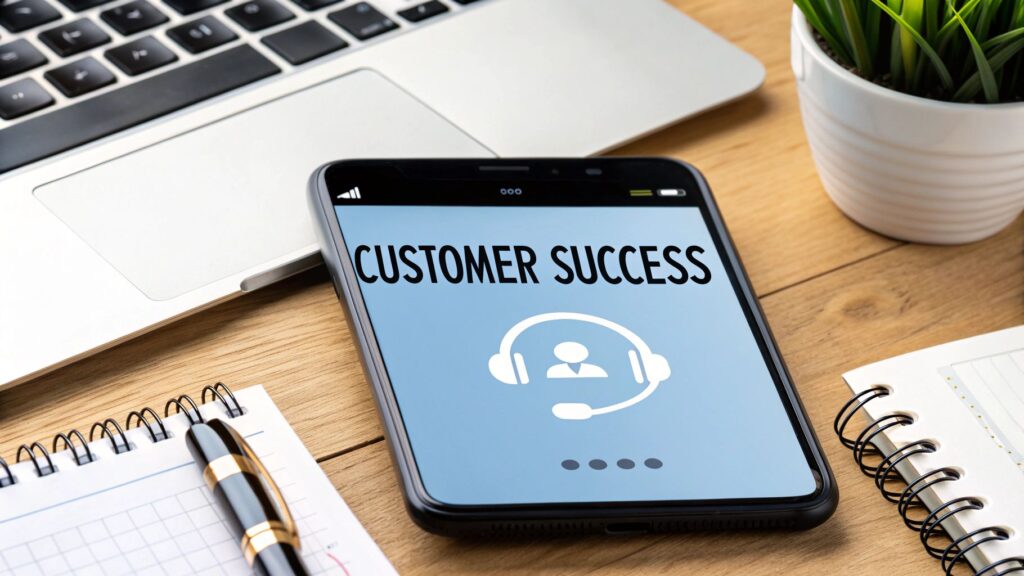In today's competitive market, every small business is looking for an edge. While you might not have the budget of a huge corporation, you have something much more valuable: the ability to build genuine, lasting relationships with your customers. This is where great service stops being a support function and becomes your most powerful tool for growth. Forget generic advice that doesn't fit your scale.
This article gets straight to the point with 10 high-impact customer service best practices designed for agile businesses using tools like WhatsApp Business and virtual phone systems. We'll cover practical, actionable strategies you can start using today to not just meet, but truly exceed customer expectations. Mastering these turns everyday chats and calls into moments that build loyalty, protect your reputation, and drive repeat business.
Whether you're a freelancer, run an e-commerce shop, work as a plumber, or own a local bakery, these techniques will help you stand out. By focusing on clear communication and proactive support, you can build the kind of customer devotion that creates a truly successful and resilient business. Let's dive into the methods that will make your service unforgettable.
1. Active Listening: The Foundation of Understanding
Great service always starts with understanding. Active listening is more than just hearing words; it’s about giving the customer your full attention, focusing on what they’re saying, their tone, and the emotions behind it. This practice is the bedrock of excellent customer service because it ensures you fully grasp the customer's problem before you try to solve it.
For a small business using WhatsApp or a virtual phone, this means reading messages carefully and responding thoughtfully, not just firing back a canned script. It’s about making the customer feel genuinely heard and valued, which is the crucial first step toward a helpful and empathetic solution. By truly listening, you turn a simple transaction into a chance to build a relationship—a key advantage in a crowded market.
“Most people do not listen with the intent to understand; they listen with the intent to reply.” – Stephen Covey
How to Implement Active Listening
Putting this customer service best practice into action takes conscious effort. Start by focusing entirely on what the customer is communicating, rather than planning your reply while they're still talking.
- Paraphrase and Confirm: Use phrases like, “So, if I understand correctly, you’re saying that…” or “Just to be clear, what I’m hearing is…” This shows you’re paying attention and confirms you’re on the same page.
- Ask Open-Ended Questions: Instead of questions that get a simple "yes" or "no," ask things like, “Could you tell me a bit more about what happened?” This encourages the customer to share important details.
- Acknowledge Their Feelings: Show empathy with statements like, “I can see how frustrating that must be,” or “I understand why you’re concerned about this.” This validates their experience and starts building trust.
2. Omnichannel Support: A Seamless Customer Journey
Today’s customers connect with businesses on multiple platforms, and they expect a smooth experience every time. Omnichannel support is a customer service best practice that connects all these touchpoints, creating one seamless journey whether the customer is on WhatsApp, a phone call, or your website. It ensures that context and conversation history are never lost, even when a customer switches from one channel to another.
For a UK-based tradesperson, this could mean a client sends a project photo on WhatsApp, calls your virtual number to discuss the details, and gets the quote via email—with each step feeling like part of one continuous conversation. This integrated approach builds customer confidence and makes your operation look professional and organised, which is vital for any small business wanting to stand out.

“You’ve got to start with the customer experience and work back toward the technology, not the other way around.” – Steve Jobs
How to Implement Omnichannel Support
Creating a unified experience takes a bit of planning and the right tools. The main goal is to make the switch between channels feel effortless for the customer.
- Integrate Your Key Channels: Start simple. Focus on connecting your most-used platforms first, like your virtual phone and WhatsApp Business account, so that information can flow between them.
- Use a Centralised System: A simple Customer Relationship Management (CRM) system can pull conversations from different channels into one customer profile, giving you a complete picture.
- Map the Customer Journey: Think about the common ways customers interact with you. This helps you see where they switch channels and where you can make the handover smoother.
- Train Your Team: Make sure everyone on your team is comfortable handling questions across all your channels while keeping the same friendly and helpful tone.
3. Proactive Customer Service: Anticipating Needs
Great service isn't just about reacting to problems; it's about getting ahead of them. Proactive customer service means identifying and solving potential issues before your customers even have to reach out. This approach flips the traditional service model on its head, turning a potential complaint into a positive, trust-building moment.
For a small business, this could be as simple as sending a WhatsApp message to a customer to double-check that their delivery address looks right, or letting clients know about a potential delay before they ask. Instead of waiting for a complaint, you reach out first, showing you’re on top of things and that you care. This is one of the most powerful customer service best practices for building loyalty because it proves you're looking out for them.

“The best way to treat a customer is to make them feel like you’re on their side, not that you’re just trying to sell them something.” – Shep Hyken
How to Implement Proactive Customer Service
Adopting a proactive mindset means shifting from reactive problem-solving to forward-thinking prevention. You can start with small, manageable steps.
- Look for Patterns: Keep an eye on common questions or issues. If several customers ask about the same product feature, create a short guide or FAQ and send it out.
- Send Timely Updates: Keep customers in the loop about order statuses, potential service disruptions, or upcoming appointments. For example, a plumber could send a text reminder to a client the day before a job.
- Use Simple Alerts: Set up automated alerts for potential problems. An e-commerce store, for instance, could automatically notify a customer if their payment method is about to expire, preventing a failed transaction down the line.
4. Empathy and Emotional Intelligence
Beyond just fixing problems, outstanding customer service is about connecting on a human level. Empathy is the ability to understand and share someone else's feelings, while emotional intelligence is about being aware of and managing emotions—both yours and your customer's. This practice is key to turning a frustrating customer experience into a positive one that builds loyalty.

For a small business like a local bakery or a tradesperson using a virtual number, this means acknowledging a customer's disappointment when an order is wrong or an appointment is missed. It's about responding with genuine care instead of defensive excuses. By showing you truly get their perspective, you build deep trust and prove that your business values people over profits—a powerful way to stand out and foster long-term customer relationships.
“People will forget what you said, people will forget what you did, but people will never forget how you made them feel.” – Maya Angelou
How to Implement Empathy and Emotional Intelligence
Integrating this customer service best practice requires a conscious shift from a transactional to a relational mindset. Start by encouraging your team to see every interaction from the customer's point of view.
- Validate Their Feelings: Use phrases that acknowledge how they feel, such as, “I can completely understand why you’d be upset about that,” or “That sounds incredibly frustrating, and I’m sorry you’re dealing with this.”
- Acknowledge and Apologise: If your business made a mistake, own it. A simple, “You’re right, we got this wrong, and I sincerely apologise for the trouble it has caused,” can defuse tension immediately.
- Practise Perspective-Taking: During team huddles, talk through difficult customer scenarios. Ask your team, “How would you feel if this happened to you?” to help build more empathetic responses.
5. First Contact Resolution (FCR): Solving It the First Time
In customer service, efficiency is king. Nothing shows this better than solving an issue on the first try. First Contact Resolution (FCR) is a key metric and one of the most impactful customer service best practices. It measures your ability to completely solve a customer's problem during their first contact, so they don't have to call back or send follow-up messages.
For a small business, like a local plumber or an online bakery using WhatsApp, a high FCR rate means happier customers and a more efficient operation. Instead of juggling a dozen ongoing issues, your team can focus on delivering great, one-touch solutions. This not only boosts customer satisfaction but also frees up valuable time, helping you build a reputation for being competent and reliable.
“The best service is no service.” – Bill Price, former VP of Global Customer Service at Amazon
How to Implement First Contact Resolution
Improving FCR is all about empowering your team with the right tools, knowledge, and authority to solve problems on the spot. Start by figuring out the main reasons customers have to contact you more than once.
- Empower Your Team: Give your staff the authority to make decisions, like processing a refund or offering a discount, without needing a manager's approval. This autonomy is crucial for solving problems immediately.
- Create a Solid Knowledge Base: Equip your team with a detailed, easy-to-search internal guide that covers common issues, product details, and clear steps for resolving them.
- Invest in Good Training: Make sure every team member is thoroughly trained not just on your products, but also on how to handle tricky questions and use all the tools at their disposal. This preparation is fundamental to FCR success.
6. Personalization and Customer Context
No one likes to feel like a number. Personalization means tailoring your service based on a customer's history, preferences, and past conversations. This practice shows that you see and value them as an individual, moving beyond a generic, one-size-fits-all approach.
For a small business using WhatsApp Business, this means having past conversations handy. You can reference a previous question or purchase, which makes the customer feel remembered and understood. This level of context is one of the most vital customer service best practices because it turns a simple support request into a meaningful, personal dialogue that strengthens your customer relationships.
“Personalization is not a trend, it’s a marketing strategy that has been proven to work.” – Neil Patel
How to Implement Personalization
Building customer context into your service requires you to be organised with your customer data. Start by making sure that information is easily accessible to your team before they respond.
- Review Customer History: Before replying, take a quick look at past conversations or purchase history. Mentioning a previous interaction, like “I see you recently asked about our delivery times…” shows you’re paying attention.
- Use Customer Data: Make use of the information you have. Addressing a customer by their name is a basic start; referencing their last order or a specific preference takes it to the next level.
- Segment Your Audience: Group customers based on their behaviour or what they've bought. This allows you to provide proactive, relevant support, like sending tailored tips for a product they recently purchased.
7. Continuous Training and Development
Great service isn't a one-time goal; it's a standard you have to consistently maintain and improve. Continuous training and development is the commitment to regularly enhancing your team's skills, product knowledge, and service abilities. This is a cornerstone of customer service best practices because it ensures your team can adapt to new tools, changing customer expectations, and any business challenges that come your way.
For a small business, this doesn't mean expensive, all-day seminars. It could be a quick 15-minute weekly huddle to discuss new questions coming in via WhatsApp, or sharing a short guide on a new feature of your virtual phone system. It’s about building a culture of learning that empowers your team to deliver amazing service, which translates directly into customer loyalty and a stronger brand.
“The only thing worse than training your employees and having them leave is not training them and having them stay.” – Henry Ford
How to Implement Continuous Training and Development
Making ongoing learning a part of your operations keeps your team sharp and motivated. Start by making training a regular, manageable part of your work schedule.
- Create a Knowledge Base: Develop a simple, shared resource (like a Google Doc or Notion page) with answers to common questions, product updates, and service guidelines. This gives your team a single source of truth.
- Focus on Soft Skills: Beyond technical know-how, train your team on empathy, problem-solving, and using positive language. Role-playing tricky customer conversations can be a really effective training tool.
- Encourage Peer-to-Peer Learning: Ask team members to share their successes and challenges. A team member who handled a difficult client call well can share their approach, creating a collaborative learning environment.
8. Service Recovery and Problem Resolution
Mistakes happen. It's how you handle them that truly defines your business. Service recovery is a planned approach to dealing with failures and complaints, aiming not just to fix the problem but to go above and beyond to restore the customer's trust. This practice turns a negative experience into a powerful opportunity to build even greater loyalty.
For a small business, one bad experience shared on a local Facebook group can be damaging. However, a thoughtful, quick resolution communicated via WhatsApp or a personal phone call can turn that unhappy customer into your biggest fan. It’s about owning the mistake and showing a genuine commitment to making things right, which is a core part of customer service best practices.
“Your most unhappy customers are your greatest source of learning.” – Bill Gates
How to Implement Service Recovery
A structured approach to fixing problems ensures you're consistent and effective. Give your team the power to act decisively when things go wrong.
- Empower Your Team: Give your frontline staff the authority to offer immediate solutions—like a discount on a future service or a complimentary item—without needing a manager's approval. This shows you trust your team and gets the customer a quick resolution.
- Establish Clear Escalation Paths: For more complex issues, have a simple process for escalating the problem. The customer should always know their issue is being taken seriously and who is handling it.
- Analyse and Improve: Keep a record of service failures. Regularly review these incidents to spot patterns and use what you learn to improve your processes, products, or training to prevent future mistakes.
- Follow Up: After you've resolved the issue, send a follow-up message. A simple, “Just checking in to make sure everything is now to your satisfaction,” reinforces your commitment and makes sure the problem is truly solved.
9. Self-Service Options and Knowledge Management
Sometimes, the best service is helping customers help themselves. Empowering customers with self-service options means giving them the tools to find their own answers, anytime they want. This practice is a cornerstone of modern customer service, as it reduces the number of support requests and frees up your team to handle more complex issues.
For a small business, this could be a simple, well-organised FAQ page on your website, with a link in your WhatsApp Business profile. It allows customers to solve common queries instantly, whether it’s about your opening hours or how to care for a product. This approach respects the customer's time and provides immediate value, positioning your business as efficient and user-friendly.
“Give your customers the gift of knowledge, and you give them the power of self-reliance.” – A modern take on customer empowerment
How to Implement Self-Service and Knowledge Management
Building an effective self-service resource is all about anticipating your customers' needs. Start by making a list of the most common questions you get.
- Create a Centralised Knowledge Base: Set up a dedicated FAQ section or help centre on your website. Organise topics logically with clear headings like "Shipping," "Returns," and "Product Information."
- Use Different Formats: People learn in different ways. Add short video tutorials or simple infographics to your text-based articles. For example, a quick video showing how to assemble a product can be much more helpful than written instructions alone.
- Keep It Updated: One of the most critical customer service best practices is to regularly review and update your self-service content. Use questions you get on WhatsApp and phone calls to find gaps and add new information. This keeps your resources relevant and trustworthy.
10. Feedback Collection and Customer Voice Programs
Excellent service isn’t a destination; it's a continuous journey of improvement fueled by what your customers tell you. A good feedback programme involves systematically gathering, analysing, and acting on customer comments. This practice is crucial for understanding what you’re doing right and, more importantly, where you can get better.
For a small business, this can be as simple as sending a follow-up WhatsApp message asking for a quick rating after a service, or sharing a link to a simple survey. It’s about creating official channels for customers to share their thoughts, making them feel heard, and showing that their opinions help shape your business. Implementing these customer service best practices ensures you're always evolving in line with what your customers want.
"Your most unhappy customers are your greatest source of learning." – Bill Gates
How to Implement Feedback Collection
Actively asking for feedback shows customers you see them as partners and are committed to giving them the best experience possible. Start by making it easy and worthwhile for them to share their thoughts.
- Use Multiple Channels: Don't just rely on one method. Use a mix of email surveys (like Net Promoter Score or NPS), quick WhatsApp polls, and listening to what people say on social media to get a full picture.
- Keep It Short and Sweet: No one likes a long, complicated survey. Ask only the most important questions to respect your customer's time and get more useful feedback.
- Close the Feedback Loop: This is the most important step. Acknowledge the feedback and, when you make a change based on it, let customers know. This shows their voice has a real impact.
Customer Service Best Practices Comparison
| Item | Implementation Complexity 🔄 | Resource Requirements ⚡ | Expected Outcomes 📊 | Ideal Use Cases 💡 | Key Advantages ⭐ |
|---|---|---|---|---|---|
| Active Listening | Moderate: Requires ongoing coaching and practice | High: Skilled representatives and training needed | Improves customer satisfaction by 15-25%, higher first-call resolution | Complex or sensitive customer interactions | Builds trust, reduces misunderstandings, identifies root causes |
| Omnichannel Support | High: Complex system integration and multi-channel training | High: Significant tech investment and staff training | Enhances brand consistency, increases lifetime value | Businesses with diverse communication channels | Seamless, consistent customer experience across channels |
| Proactive Customer Service | High: Sophisticated monitoring & predictive analytics | High: Analytics tools, CRM systems, and AI needed | Reduces support tickets by 20-30%, satisfaction +10-15% | Service with frequent issues or maintenance needs | Prevents problems, builds loyalty, reduces incoming contacts |
| Empathy & Emotional Intelligence | Moderate: Requires ongoing soft skills training | Moderate: Emotional intelligence development programs | Emotionally connected customers are 52% more valuable | High-touch, emotionally charged interactions | Strong emotional bonds, reduces churn, enhances loyalty |
| First Contact Resolution (FCR) | Moderate-High: Extensive training and access to info | High: Training, knowledge bases, agent empowerment | Increases satisfaction and loyalty, cost reduction | All customer service settings | Resolves issues on first contact, reduces repeat contacts |
| Personalization & Customer Context | High: Complex data integration and privacy compliance | High: CRM, analytics, AI tools | Increases satisfaction, loyalty, and upselling | Customer-focused, data-rich environments | Tailored experiences, stronger relationships |
| Continuous Training & Development | Moderate-High: Requires ongoing programs and assessments | High: Time, budget (3-5% revenue), and resources | Improves service quality & employee retention | Organizations prioritizing quality and adaptability | Maintains skills, adapts to change, improves engagement |
| Service Recovery & Problem Resolution | Moderate: Needs escalation processes and skilled reps | Moderate-High: Compensation, training, resources | Converts dissatisfied customers, reduces negative word-of-mouth | Post-service failure situations | Turns failures into loyalty opportunities |
| Self-Service & Knowledge Management | Moderate-High: Content creation and tech setup | Moderate-High: Maintenance and updates | Reduces support costs, available 24/7 | High volume, common inquiries | Customer empowerment, scalable support |
| Feedback Collection & Customer Voice | Moderate: Multi-channel setup and analysis | Moderate: Tools for surveys, social monitoring | Provides actionable insights for improvement | Continuous service refinement | Drives improvements, engages customers, informs strategy |
Putting These Practices into Action
You've just explored ten of the most powerful customer service best practices that can genuinely transform your business. From the core skill of active listening to the strategic use of feedback, each principle is a building block for creating amazing customer experiences. It’s a lot to take in, and trying to implement everything at once can feel daunting.
The key takeaway is not to perfectly master all ten by tomorrow. Instead, think of this as a toolkit. Your goal is to pick the right tool for the job that your business and your customers need most right now. Great customer service is a continuous journey of improvement, not a final destination.
Your Actionable Next Steps
To go from reading to doing, start small and build momentum. Don't try to overhaul your entire support process overnight.
- Choose Your Focus: Pick one or two practices from this list that solve your biggest headache. Is your team struggling to fix issues on the first try? Focus on First Contact Resolution (FCR). Do customers complain about feeling like just another ticket number? Prioritise Personalization and Customer Context.
- Leverage Your Tools: You don’t need a massive budget to deliver first-class service. By combining the user-friendly interface of WhatsApp Business with a professional virtual number, you create a powerful, central hub for all customer communication. This setup makes it easier to offer omnichannel support, provide proactive updates, and keep that personal touch.
- Measure and Adapt: Once you've made a change, track its impact. Are your customer satisfaction ratings going up? Are you seeing fewer repeat queries? Use this data to fine-tune your approach and decide which of the customer service best practices to focus on next.
Building a Legacy of Loyalty
Ultimately, investing in these practices is about more than just fixing problems—it’s about building relationships. Every positive, helpful, and efficient interaction adds to your brand's reputation. When you make customers feel heard, understood, and valued, you're not just providing support. You are building a loyal community of advocates who will champion your business, refer new customers, and stick with you for the long run. That loyalty is the most valuable asset a small business can have.
Ready to centralise your customer communications and build a more professional brand image? A dedicated virtual number from Business Numbers Direct seamlessly integrates with tools like WhatsApp Business, giving you the foundation to implement these best practices effectively. Explore our plans and take the first step towards transforming your customer service today.




